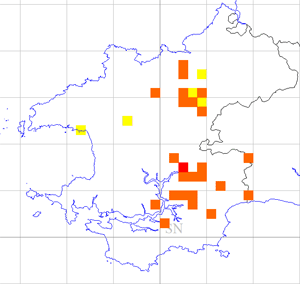Tree Pipit - 2003-07
 Friday, May 11, 2012 at 9:24PM
Friday, May 11, 2012 at 9:24PM Since the 1984-88 tetrad survey, Tree Pipits have undergone significant declines as a breeding species in Pembrokeshire.
These data suggest that Tree Pipits have disappeared from ca. 60% of the tetrads in which they were recorded in the 1984-88 survey. A glance at the tetrad map confirms that, whilst the strong bias in distribution remains east of a line from Newport on the north coast to the east of the Daugleddau Estuary, Tree Pipits are now absent from the majority of tetrads in which they were recorded in the first tetrad survey to the west of this line. The 25 tetrads in which Tree Pipits were recorded as confirmed or probable breeding in the 2003-07 survey are clustered around the Gwaun Valley and lower flanks of the Preseli Hills, and around the Canaston/Minwear Woods and areas south to Lawrenny and Martletwy in mid Pembrokeshire.
The dramatic rate of decline suffered by this species in Pembrokeshire far outstrips the national rate of decline. The BBS data for the UK during the period of 1994 and 2007 indicated a rate of change of -11% and raises questions about its future in the county. The reasons for the rapid decline in the breeding population of Tree Pipits are not known, although factors such as loss or deterioration in the quality of breeding habitat are likely to have played a major part.
Habitat loss has almost certainly occurred, as forestry plantations have either been clear-felled or have matured and closed-over; woodland glades have been in-filled by scrub or bracken encroachment, and structurally diverse edges to semi-natural habitats have been lost, as a result of changes in farming practices. Other key factors are likely to include survival of birds on their sub-Saharan wintering grounds. The 1984-88 survey used an estimated average density of 10 pairs per occupied tetrad to arrive at a county population estimate of 800 pairs. The breeding population during the 2003-07 survey, using the same density estimate, was probably 250 pairs, or less if the average density had decreased.
Jane Hodges

Fieldwork 2003-07 (based on 490 tetrads)
Red = breeding confirmed = 1
Orange = breeding probable = 24
Yellow = breeding possible = 5
Total tetrads in which registered = 30 (6.1%)
 JEH,
JEH,  PBBA 2003-7 in
PBBA 2003-7 in  Tree Pipit
Tree Pipit 

Reader Comments